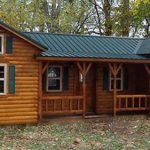Man Builds $150 Mobile Tiny Home He Can Tow With His Bike
There’s camping in a tent and then there’s camping in a trailer. Paul Elkins put both together to create a $150 mobile tiny home that could be towed around on a bicycle. All you need is some materials and Elkins’s printable instruction manual that costs only $20.Advertisement
You may be able to buy a tent for cheaper but this one is truly a mobile home with a skylight, a bed, and even a mini kitchen. The home only weighs about 60 pounds, easy to tow with a bike. This is rugged camping for those who don’t want to sleep on the ground. Advertisement
A TOUR OF THE $150 MOBILE TINY HOME
The bicycle camper’s design was based on Elkins’s previous creation, the homeless emergency shelter. Both used arched panels to maintain the structure. This form keeps the building process simple while still being firm enough to function as a home. [1] Advertisement
He got the plastic material from recycled campaign signs. “Freebies,” he called them in a YouTube video about the project. Advertisement

The front of the shelter is rounded and painted with spray paint intended for plastic. Aside from the aesthetics, the paint can help protect from UV rays.

Other than the manual, materials needed include bicycle wheels, wood for the frame, insulation, duct tape, screws, zip ties, paint, etc. All amounts to about $150. Advertisement
INSIDE THE NOMAD BICYCLE CAMPER
Once inside, the walls are strong enough to recline against, and the skylight with small windows draw in natural light. The skylight can be opened and closed. Advertisement

In this $150 mobile tiny home, he installed an LED light for reading at night. There are also reflective lights on the back of the camper. Advertisement

In the center stands a foam sheet that serves as a bed.

Read: Nonprofit Organization Built Homeless Veterans Village of Tiny Homes Instead Of Leaving Them HomelessAdvertisement
He added over cabinets to store food and supplies as well as little counters to prepare food on. One of which includes a single-burner portable stove. He even attached speakers to both overhead cabinets for a surround sound effect for the person lying in bed. “We got to have that,” he said. “I don’t like headphones.”

He also keeps little storage units for books and other supplies, as well as a cooler. The cabinets also lock in place to prevent messes while traveling.
Air vents flaps lie where the occupant sleeps at the end of the camper. Aside from enjoying the fresh breeze, the vents help with air circulation and reduce condensation.

Two layers of fluted plastic make up the door, which Elkins covered with yellow and black safety tape.

He attached an extra bin underneath the camper for heavier items to maintain the center of gravity while traveling in windy areas

If he planned to take the camper on a real road trip, he would install a solar panel to power the batteries for the lights and stereo system instead of relying on batteries.
Other Eklins designs include the shelter the camper was based on, a wooden mini-boat, and a dog house among others. These manuals are available on his website which ranges from $5 to $20. This $150 mobile tiny home is one of his many amazing projects
ABOUT THE DESIGNER, PAUL ELKINS
Paul Elkins considers himself a “novice artist and designer” since he had training in art but not in engineering. He fell in love with innovation when he was a child visiting extended relatives on the countryside. His cousin’s farm and home were covered with hand-made machines and tools.
“He made whatever he needed, showing me that a person with a little ambition, skill, and imagination could accomplish damn near anything!” he writes on his website.
His artistic doodles became designs for boats, houses, and cars. From there, he began developing prototypes of his ideas and posting them on his website and on YouTube.
He used to work for Boeing, but now he focuses on creating mini structures that are weatherproof, lightweight, and often transportable with the help of bicycle pedals.
“His work is inspiring because he pushes minimalism to an extreme,” wrote filmaker Kirsten Dirksen on the Tiny House Design. “While his tiny structures are lightweight, weatherproof, and portable they are also functional and include all the essentials. From a tiny house design perspective, his work serves an extreme example that sets the standard for small and outside-the-box thinking.”




Leave a Reply